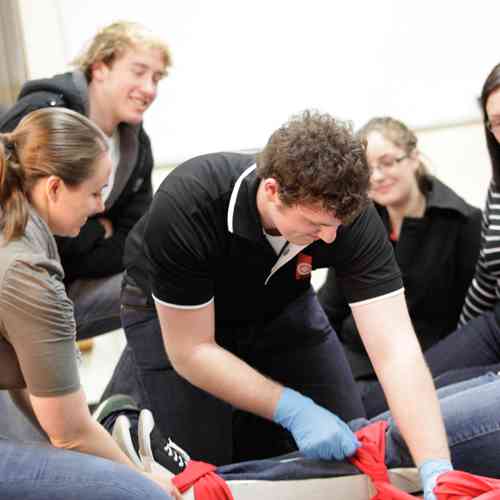Introduction
In today's busy work environment, safety and security is critical. Organizations are significantly recognizing the importance of producing a safe area for workers. Among the most vital elements of work environment safety training is initial help and mouth-to-mouth resuscitation (Cardiopulmonary Resuscitation) programs. These training courses not just encourage employees with important life-saving skills however also foster a society of security within the organization. In this short article, we will certainly look into the myriad reasons that office security training should consist of first aid and mouth-to-mouth resuscitation courses, highlighting their relevance in boosting office safety.
Why Work environment Safety and security Training Ought To Include Emergency Treatment and Mouth-to-mouth Resuscitation Courses
The integration of first aid and mouth-to-mouth resuscitation courses into work environment safety training has far-ranging benefits. They gear up workers with the understanding and skills needed to respond efficiently to medical emergency situations, minimize recuperation time for damaged individuals, and possibly conserve lives. Furthermore, having actually trained personnel on-site can impart self-confidence among employees and assure them that their well-being is prioritized.
Understanding Initial Aid
First help describes the immediate care supplied to a private suffering from a minor or serious illness or injury until specialist clinical aid gets here. Understanding fundamental first aid principles can make a substantial difference in emergency situation situations.
Key Components of First Aid
Assessment: The ability to analyze a situation swiftly can aid establish the proper activities needed. Stabilization: Comprehending just how to stabilize a hurt person protects against further harm. Communication: Properly communicating with emergency situation solutions is critical for timely assistance.The Significance of CPR
CPR is a life-saving strategy made use of in emergency situations when someone's heart beat or breathing has actually stopped. It includes chest compressions and rescue breaths First Aid Course Canberra to preserve blood flow and oxygenation till expert aid arrives.
How mouth-to-mouth resuscitation Works
- Chest Compressions: These help distribute blood throughout the body. Rescue Breaths: These provide oxygen to the lungs.
Benefits of Emergency treatment and CPR Certification
Obtaining an emergency treatment certificate or completing mouth-to-mouth resuscitation programs features various benefits, both for people and organizations.
Enhanced Employee Confidence: Staff members feel much more safe and secure recognizing they possess life-saving skills. Reduced Recovery Time: Quick action via first aid can cause better results for injured individuals. Compliance with Regulations: Many markets require certified employees as component of their health and wellness regulations.Creating a Culture of Security Through Training
Implementing first aid and mouth-to-mouth resuscitation training cultivates a culture that focuses on employee health.
Encouraging Teamwork
Training sessions frequently involve team-building workouts that improve partnership among employees.
Building Trust fund Between Staff members and Management
When monitoring invests in staff member training, it reveals commitment to their wellness, resulting in boosted morale.

First Aid Courses vs. CPR Courses: What's the Difference?
While both types of training courses are vital, they focus on different skill sets.
First Help Courses
These training courses cover a variety of subjects beyond simply heart emergency situations, including:
- Wound care Burns Choking
CPR Courses
CPR programs especially concentrate on strategies associated with cardiac arrest situations, highlighting:
- Adult CPR Child/ infant resuscitation Use of an Automated External Defibrillator (AED)
Choosing the Right Training Provider
Not all training providers are developed equivalent; for that reason, picking one that satisfies your organization's requirements is critical.
Accreditation Matters
Ensure that your picked service provider uses approved courses identified by relevant authorities.

Instructor Experience
Consider trainers' credentials; knowledgeable trainers often give richer knowing experiences via real-world examples.
Incorporating Emergency treatment right into Workplace Safety And Security Policies
Organizations ought to integrate emergency treatment demands right into their more comprehensive safety and security policies for comprehensive coverage.

Regular Training Updates
Conducting normal correspondence course guarantees that understanding remains present amongst employees.
Creating Emergency Feedback Plans
Having clear plans in place can guide experienced personnel throughout emergencies.
Legal Ramifications of Emergency treatment Training in the Workplace
Employers have lawful duties regarding office security; implementing emergency treatment training can help reduce threats associated with non-compliance.
Negligence Claims
Failure to give sufficient training might leave employers susceptible to suits if a case occurs as a result of absence of preparedness.
FAQ Section
What is consisted of in a typical first aid course?- A normal first aid course includes instruction on examining injuries, dealing with injuries, managing burns, taking care of choking incidents, and doing CPR if necessary.
- Most mouth-to-mouth resuscitation programs last between 4-- 6 hours depending on whether it's fundamental or advanced training.
- While not constantly legally mandated, having certified staff members can significantly improve work environment safety standards.
- Many approved organizations provide on-line revival alternatives for first aid certifications that include assessments using video clip conferencing.
- Yes, industries such as construction, healthcare, education, and manufacturing commonly have governing needs necessitating skilled employees on site.
- It's advised that employees take part in correspondence course every 2 years or quicker if there are substantial modifications in procedures or regulations.
Conclusion
To sum up, integrating emergency treatment and CPR into office safety and security training is not simply an alternative but a need in today's workplace where emergency situations can occur at any moment. Organizations benefit profoundly from having actually educated workers ready to react successfully throughout crises while fostering an ambience where employee wellness takes precedence over all else. Therefore, it ends up being evident why workplace safety and security training need to include first aid and CPR programs-- they save lives while advertising a proactive method towards health and wellness standards within companies throughout different sectors.
By focusing on such crucial training campaigns-- emergency treatment certifications gotten via reliable companies together with practical hands-on experience-- firms can dramatically enhance their general emergency situation preparedness degrees while likewise developing more powerful groups capable of taking on any kind of scenario head-on!